Effects of RF-circuit Nonlinear Distortion on Digitally Modulated Signals in Wireless Communications
Computer simulation and measurement of the error vector magnitude (EVM) and adjacent-channel power ratio (ACPR) of a 2.4 GHz MMIC power amplifier (PA) and a 2.4 GHz transceiver RF front end for digital wireless communications are presented. A computer simulation based on p /4-differential quadrature phase-shift keying (DQPSK) modulation with a square-root raised cosine (SRRC) filter is established and EVM and ACPR related to the input power are accurately predicted. The nonlinear effects of the RF circuits are modeled as traditional nonlinearity parameters by which the EVM and ACPR are simulated. Measured results agree with the simulation curves demonstrating that the developed computer simulation program by MATLAB is useful in the design of power amplifiers for digital wireless communications.
Fu-Ling Lin, Shin-Fu Chen and Huey-Ru Chuang
National Cheng Kung University,
Department of Electrical Engineering
Tainan, Taiwan, ROC
In cellular communication, the nonlinearity results mainly from the power amplifier in a portable radio. This nonlinearity deteriorates the performance of the digitally modulation signal and generates sidelobe regrowth. The modulation block and the nonlinear effect are shown in Figure 1 . The EVM and the ACPR related to the input power can be accurately predicted using digital signal processing techniques and a time-domain approach. The EVM measurement, as shown in Figure 2 , is based on measurement of the instantaneous difference between a vector-modulated signal and an ideal noise-free reference version of itself.1,2 The measurement provides invaluable insights into digitally modulated communication systems.3 The ACPR, as shown in Figure 3 , relates to spectral regrowth and is a figure of merit on circuit linearity, especially for nonconstant envelope modulation techniques.4

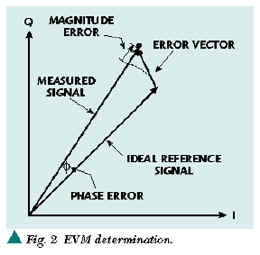

This article proposes a MATLAB program to accurately predict the EVM and ACPR based on the third-order intercept point IP3 nonlinear parameter. The IP3 is the theoretical point at which the desired signal and third-order distortion products are equal in amplitude and determines the amount of intermodulation distortion (IMD) products that exist in the mildly nonlinear circuit.5 A computer simulation based on a gray coding p /4-DQPSK modulation with SRRC filter is established to study the nonlinear effect. Simulation results are presented and discussed.
PRINCIPLES
Amplitude distortion is the most common nonlinearity characterization of a class-A power amplifier. Usually the amplifier is memoryless; that is, its output voltage is an instaneous function of its input voltage.6 In general, the input power is less than the 1 dB compression point. In this case, its nonlinearity is weak, and then the output voltage eo (t) can be approximately represented by a power series of the input voltage vi (t) as6 (Equation 1)
V0 =kl vi + k2 vi 2 + k3 vi 3
Assuming that the input signal consists of two equal amplitude (denoted as A) sinusoids at two different frequencies w1 and w2 (>w1 ) and Dw=|w1 - w2 | <<w1 , w2 , then (Equation 2)
vi =A(cosw1 t + cosw2 t)
Applying this signal to Equation 1 produces two pairs of spurious signals, which will pass through filters (these terms also called two tone IMD products) and yields

One pair is located at frequencies w 1 and w 2 with voltage 9k3 A3 /4; the other pair is located at 2w 1 ? w 2 and 2w 2 ? w 1 with voltage 3k3 A3 /4.6 Note that these spurious signals fall within the passband and can distort the fundamental frequencies w 1 and w 2 . Figure 4 shows an example of a two-tone test.

The input signal now is changed to a digitally modulating signal, for example, p /4-DQPSK modulation with an SRRC filter.7 To predict the behavior for such non-constant envelope signals is not easy when it passes through the power amplifier. The output signal close to the desired channel consists of two terms, one is the desired in-band amplified signal related to linear gain, and the other is the third-order IMD related to IP3. The IMD term can be separated into three parts, as shown in Figure 5 . One part is called in-band aliasing distortion, which results in poor EVM performance; the others are called out-of-band IMD, which result in the spectral regrowth and cause serious ACPR performance degradation. In a cellular communication system, the PA generates adjacent-channel interference due to spectral regrowth.8 A MATLAB program is established for calculating the EVM and the ACPR resulting from a PA with mild nonlinearity.

SIMULATION AND MEASUREMENT RESULTS
2.4 GHz MMIC PA
A designed 2.4 GHz MMIC PA features 11.5 dB gain, 28.5 dBm output third-order intercept point (OIP3) and 17.2 percent power-added efficiency (PAE). Figure 6 shows the measured characteristics of the 2.4 GHz MMIC PA. The circuit diagram and layout are shown in Figure 7 . Figure 8 shows the two-tone test and OIP3 measurement where OIP3 = (3Pw1 - P2 w1- w2 )/2, Pw1 = 6.67 dBm and P2 w1- w2 = -37dBm. The measured EVM is approximately 5.47 percent, as shown in Figure 9 , and the ACPR, shown in Figure 10 , is approximately 25.6 dBc when operated at the 1 dB compression point. In the simulation, the input parameters are given as

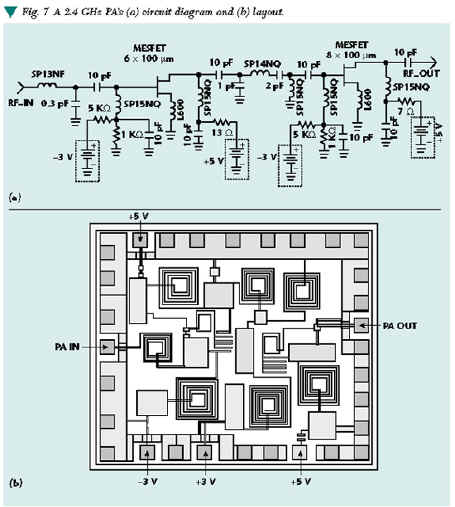



G = power gain of the MMIC PA
=11.5 dB
OIP3 = output third-order intercept point of the MMIC PA
= 28.5 dBm
Sr = symbol rate for the p /4-DQPSK modulator
= 24.5 kHz
* = roll-off factor of the SRRC filter
= 0.35
NTRN = number of the truncated symbols for the SRRC impulse response waveform
= 8
BWmain =bandwidth of the main channel
= 33 kHz
BWadj? = bandwidth of the adjacent channel
= 24.5 kHz
fadj = center frequency of the adjacent channel = fc + 30 kHz
Figures 11 and 12 show the simulation curves for EVM and ACPR, respectively. The simulation results agree well with the measured data.


2.4 GHz Transceiver
Figure 13 shows a 2.4 GHz transceiver RF front end (not including the frequency synthesizer) assembled on a FR-4 (e r = 4.7) printed circuit board, and Table 1 lists its performance characteristics.9 Figure 14 shows the measured results of the transmitting modes. The measured EVM is approximately 1.5 percent and the ACPR is approximately ?30 dBc at 2.4 GHz. In the simulation of nonlinear effects on EVM and ACPR for the transmitting mode, the input parameters are given as
|
G |
= |
24.7 dB |
|
OIP3 |
= |
31.3 dBm |
|
Sr |
= |
192 kHz |
|
* |
= |
0.35 |
|
NTRN |
= |
8 |
|
BWmain |
= |
380 kHz |
|
BWadj |
= |
380 kHz |
|
fadj |
= |
fc + 380 kHz |
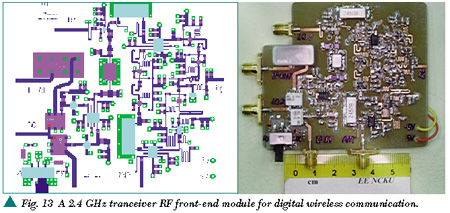
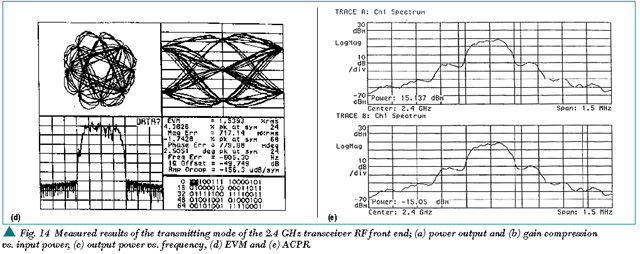
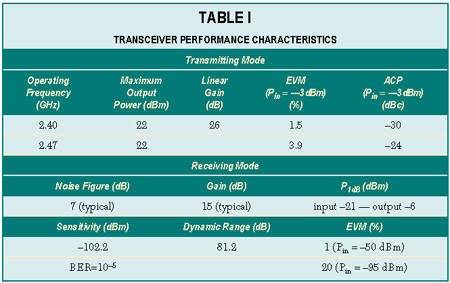
Figures 15 and 16 show the simulation curves for EVM and ACPR at 2.4 GHz, respectively. The simulation results agree well with the measured data. The results show the usefulness of the developed computer simulation program.


CONCLUSION
Computer simulation and measurement of the EVM and ACPR of a 2.4 GHz MMIC power amplifier and a 2.4 GHz transceiver RF front end for digital wireless communications have been presented. The nonlinear effects of the RF circuit can be simply modeled as a traditional nonlinearity parameter, such as the third-order intercept point IP3. The measured results agree well with the simulation curves. The results show that the developed MATLAB computer simulation program is useful to RF/microwave system engineers in the design of power amplifiers for digitally wireless communications. *
References
??????????? 1.???????? K. Voelker, "Apply Error Vector Measurements in Communications Design," Microwaves & RF , December 1995, pp. 143?152.
??????????? 2.???????? R. Hassum, M. Flaherty, R. Matreci and M Taylor, "Effective Evaluation of Link Quality Using Error Vector Magnitude Technique," Proceedings of IEEE Wireless Communications Conference , 1997, pp. 89?94.
??????????? 3.???????? M.S. Heutmaker, "The Error Vector and Power Amplifier Distortion," Proceedings of IEEE Wireless Communications Conference , 1997, pp. 100?104.
??????????? 4.???????? J.F. Sevic and J. Staudinger, "Simulation of Power Amplifier Adjacent-channel Power Ratio for Digital Wireless Communication Systems," Proceedings of IEEE Veh. Tech. Conference , 1997, pp. 681?685.
??????????? 5.???????? P. Vizmuller, RF Design Guide , Artech House, Norwood MA, 1995.
??????????? 6.???????? T.T. Ha, Solid-state Microwave Amplifier Design , John Wiley & Sons, New York, 1981.
??????????? 7.???????? S. Chennakeshu and G.J. Saulnier, "Differential Detection of ?/4-shifted-DQPSK for Digital Cellular Radio," IEEE Transactions on Veh. Tech. , Vol. VT-42, No. 1, February 1993, pp. 46?57.
??????????? 8.???????? S.W. Chen and R. Gilmore, "Effect of Nonlinear Distortion on CDMA Communication Systems," IEEE Transactions on Microwave Theory and Techniques , Vol. 44, No. 12, December 1996, pp. 2743?2749.
??????????? 9.???????? S.Y. Liu and H.R. Chuang, "2.4 GHz Transceiver RF Front-end for ISM-band Digital Wireless Communications," Applied Microwave & Wireless , June 1998, pp. 32?48.
 Fu-Ling Lin received his PhD degree in electrical engineering from National Cheng Kung University, Tainan, Taiwan, in 2000. From 1984 to 1988 and 1990 to 1995, he was a wireless communication engineer at the Chung Shan Institute of Science and Technology (CSIST), Taiwan. He is currently an assistant professor in the department of electronics engineering at Southern Taiwan University of Technology, Tainan, Taiwan. His research interests include digital wireless communication and RF system design.
Fu-Ling Lin received his PhD degree in electrical engineering from National Cheng Kung University, Tainan, Taiwan, in 2000. From 1984 to 1988 and 1990 to 1995, he was a wireless communication engineer at the Chung Shan Institute of Science and Technology (CSIST), Taiwan. He is currently an assistant professor in the department of electronics engineering at Southern Taiwan University of Technology, Tainan, Taiwan. His research interests include digital wireless communication and RF system design.
 Shin-Fu Chen received his BSEE and MSEE degrees from National Cheng Kung University, Tainan, Taiwan, in 1997 and 1999, respectively. Since 1999, he has been a systems application engineer at the Electronic Research and Service Organization (ERSO), Hsinchu, Taiwan. His research interests include wireless communication systems and RF circuits/RFIC design.
Shin-Fu Chen received his BSEE and MSEE degrees from National Cheng Kung University, Tainan, Taiwan, in 1997 and 1999, respectively. Since 1999, he has been a systems application engineer at the Electronic Research and Service Organization (ERSO), Hsinchu, Taiwan. His research interests include wireless communication systems and RF circuits/RFIC design.
 Huey-Ru Chuang received his BSEE and MSEE degrees from the National Taiwan University, Taipei, Taiwan, in 1977 and 1980, respectively, and his PhD degree in electrical engineering from Michigan State University, East Lansing, MI, in 1987. From 1987 to 1988, he was a post-doctoral research associate at the Engineering Research Center, Michigan State University. From 1988 to 1990, he was with the Portable Communication Division, Motorola Inc., Ft. Lauderdale, FL. He joined the department of electrical engineering, National Cheng Kung University, Tainan, Taiwan, in 1991, where he is currently a professor. His research interests include electromagnetic computation of the human interaction with portable antennas and EM fields, wireless communication antenna and RF/microwave circuits design, RFIC/MMIC, EMI/EMC and microwave communication and detection systems.
Huey-Ru Chuang received his BSEE and MSEE degrees from the National Taiwan University, Taipei, Taiwan, in 1977 and 1980, respectively, and his PhD degree in electrical engineering from Michigan State University, East Lansing, MI, in 1987. From 1987 to 1988, he was a post-doctoral research associate at the Engineering Research Center, Michigan State University. From 1988 to 1990, he was with the Portable Communication Division, Motorola Inc., Ft. Lauderdale, FL. He joined the department of electrical engineering, National Cheng Kung University, Tainan, Taiwan, in 1991, where he is currently a professor. His research interests include electromagnetic computation of the human interaction with portable antennas and EM fields, wireless communication antenna and RF/microwave circuits design, RFIC/MMIC, EMI/EMC and microwave communication and detection systems.
